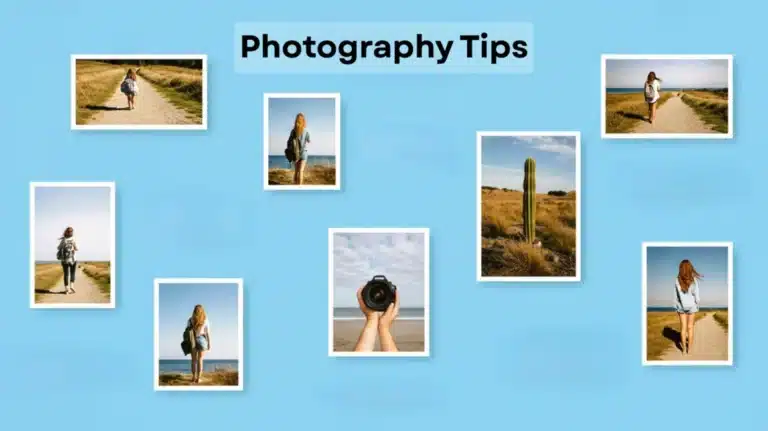Photography is more than just clicking a button—it’s about storytelling, creativity, and technique. For beginners, stepping into the world of photography can be overwhelming, but with the right guidance, you can turn your passion into powerful images. Whether you use a DSLR, mirrorless, or smartphone camera, this guide will walk you through essential photography tips for beginners that will set you on the path to capturing stunning photos.
Why Photography Matters Today
In the age of social media and digital storytelling, photography plays a major role in how we express ourselves. From documenting travels to capturing life’s little moments, learning how to take great photos gives you the power to connect with people emotionally.
Whether you’re starting a photography blog, launching a career, or simply shooting for fun, improving your basics is the key to long-term growth.
1. Understand Your Camera
The first step for any beginner is to understand the gear you’re working with. Whether it’s a Canon, Nikon, Sony, or even your smartphone, explore the following:
-
Learn the basic modes: Auto, Manual (M), Aperture Priority (A/Av), and Shutter Priority (S/Tv).
-
Understand the exposure triangle: This includes ISO, shutter speed, and aperture. These three work together to create balanced exposures.
-
Practice shooting in manual mode: It may seem complex at first, but gives you full creative control.
2. Master the Exposure Triangle
Exposure is what determines how light or dark your image will be. Here’s a quick breakdown:
| Component | Controls | Effects on Photo |
|---|---|---|
| ISO | Light sensitivity | Higher ISO = brighter, but noisier |
| Shutter Speed | Motion freeze or blur | Faster = sharper, slower = motion blur |
| Aperture (f-stop) | Depth of field | Lower f = blurred background (bokeh) |
3. Focus on Composition
The way you frame your subject can make or break your photo. Follow these beginner-friendly rules:
-
Rule of Thirds: Imagine your frame divided into 9 equal parts—place subjects where the lines intersect.
-
Leading Lines: Use natural lines (roads, fences, shadows) to draw the viewer’s eyes to the subject.
-
Fill the Frame: Get closer or zoom in to eliminate distractions and emphasize your subject.
📸 Try composing without relying on post-editing—this will develop your eye for a balanced photo.
4. Use Natural Light to Your Advantage
Lighting is everything in photography, and photography tips for beginners often emphasize the importance of using natural light to enhance image quality:
-
Golden Hour: Shoot during sunrise or sunset for warm, soft light.
-
Avoid midday light: Harsh sunlight creates strong shadows.
-
Position your subject well: Always ensure your main light source (like the sun or a window) is facing your subject.
If you’re indoors, place subjects near windows, and turn off overhead lights to avoid mixed lighting.
5. Practice with Different Angles
Great photos come from creative perspectives. Don’t just shoot at eye level:
-
Try shooting from high above or ground level.
-
Tilt your camera for diagonal composition.
-
Move around your subject to find the most flattering angle.
This helps break monotony and adds interest to even simple scenes.
6. Start Editing Your Photos
Post-processing is where your photos come alive. Use beginner-friendly editing apps like:
-
Lightroom (mobile & desktop)
-
Snapseed (for mobile editing)
-
VSCO (easy filters and manual tools)
Begin with the basics:
-
Adjust brightness and contrast
-
Crop and straighten
-
Slightly boost colors
-
Remove unwanted elements
Don’t over-edit—aim for a natural and clean result that enhances the original image.
7. Use a Tripod for Stability
A tripod may seem like a professional tool, but it’s invaluable for beginners too:
-
Great for low-light photography and night shots
-
Helps maintain consistent framing (especially for flat lays or videos)
-
Useful for self-portraits and long exposure shots
You can start with a lightweight, budget-friendly tripod before upgrading later.
8. Practice, Practice, Practice
The best way to improve is to shoot every day. Set challenges like:
-
Take 10 photos of the same subject from different angles
-
Practice shooting in different lighting conditions
-
Try out different themes (street, nature, portraits)
Build your portfolio gradually and look back to track your progress.
9. Learn from Other Photographers
Join communities where you can learn from other beginners and pros:
-
Instagram & Pinterest – Great for inspiration
-
YouTube channels like Peter McKinnon or Mango Street
-
Reddit communities such as r/photography or r/itookapicture
Engaging in critique and discussion helps you refine your style and technique.
10. Don’t Obsess Over Gear
Many beginners believe better gear = better photos. In reality:
-
A great photo is about vision, light, and story, not just pixels.
-
Focus on your skills and creativity instead of buying expensive equipment.
-
Even smartphones today have advanced capabilities—use them wisely.
Invest in your growth first before upgrading your gear.
Final Thoughts
Embarking on your photography journey can be both exciting and intimidating. With these photography tips for beginners, you now have a roadmap to start capturing beautiful and meaningful photos. Remember, every great photographer was once a beginner. The key is to keep learning, experimenting, and enjoying the process.
Frequently Asked Questions (FAQs)
Q1. How often should I practice photography as a beginner?
Ideally, aim to shoot something every day or at least a few times a week. Consistency is key to improvement.
Q2. Do I need a DSLR to take good photos?
No. Many smartphones and compact cameras today offer excellent image quality. The most important factor is how you use the camera you have.
Q3. Should I shoot in RAW or JPEG?
As a beginner, you can start with JPEG, but try RAW once you’re comfortable. RAW files retain more image data, which is helpful for editing.





